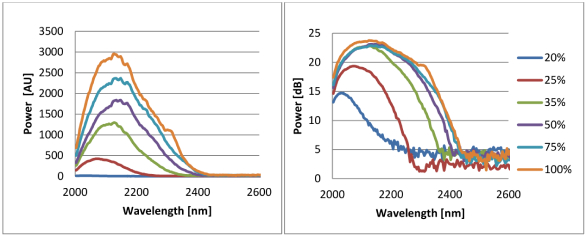This application note describes the use of ARCspectro FT-NIR and FT-MIR for measuring modulated (or pulsed) light sources. It is shown that pulsed light sources with frequencies ranging from 10kHz to over 80Mhz can be measured with our systems.
The ARCspectro FT series are scanning Fourier-transform spectrometers. These instruments use a white- light interferometer to record an interferogram by scanning the position of one of the interferometer mirrors. Nevertheless, time-varying light sources can be measured with the Arcspectro FT series, provided that the frequency of the source lies outside the interferometer modulation frequency range. Typically, the interferometer modulation frequencies are in the order of a few kHz. Furthermore, a digital filter is implemented in the processing, which filters out any frequency component lying outside the 100 Hz - 10kHz range (these are indicative values that might differ from one spectrometer type to another). Modulated or pulsed light sources can be measured provided that their frequency (or repetition rate) lies above of the higher interferometer modulation frequency (typically 10kHz). Below are three measurement examples.
As a first example, a 2.5mW LED emitting broadly around \( 1.55\mu\text{m} \) was measured using an ARCspectro FT- NIR equipped with a 0.9-2.6 microns InGaAs detector. The LED output was modulated at different frequencies using a function generator.
Figure 1 shows 10 subsequent measured spectra of the LED modulated at 15 kHz. This frequency is above the interferometer modulation frequencies and internal digital fileter. Therefore, the spectrum of the LED is measured normally.

FIGURE 1 - LED WITH 15KHZ MODULATION FREQUENCY
Figure 2 shows 10 subsequent measured spectra of the LED, but this time modulated at 8 kHz. This frequency lies within the interferometer modulation frequencies, and below the cut-off of the internal digital filter. As a consequence, aliasing artifacts are clearly visible for wavelengths shorter than the LED central wavelength.

FIGURE 2 - LED WITH 8KHZ MODULATION FREQUENCY
A pulsed supercontinuum source similar to, but not identical to, a NKT Photonics SuperK Extreme EXW-12 system was measured on a Arcoptix FT-MIR 2.0-6.0.
This supercontinuum source delivers light in ca 500 ps pulses with 80 MHz covering a spectrum of 450-2400 nm with an average power of about 5W. The spectrum was measured on the Arcoptix FT-MIR 2-6.0 with a diffusion lens before the FT-MIR to reduce the intensity of the 1mm collimated beam from the supercontinuum source. The laser power was varies from 20 to 100%. Results are shown on Figure 3.

FIGURE 3 - 80MHZ PULSED SUPERCONTINUUM SOURCE. LINEAR (LEFT) AND LOGARITHMIC SCALE (RIGHT)
A SuperK Compact from NKT Photonics was also measured on the Arcoptix FT-MIR 2.0-6.0. The SuperK Compact delivers 100mW of pulses with a length of approx. 1 ns and a repetition rate of 24kHz. The spectrum covers 500-2500nm. For this measurement the collimated output of the SuperK Compact was slightly diffused with a lens before being free-space coupled into the FT-MIR. Results are shown on Figure 4.

FIGURE 4 - 24KHZ PULSED BROADBAND SOURCE. LINEAR (LEFT) AND LOGARITHMIC SCALE (RIGHT)
